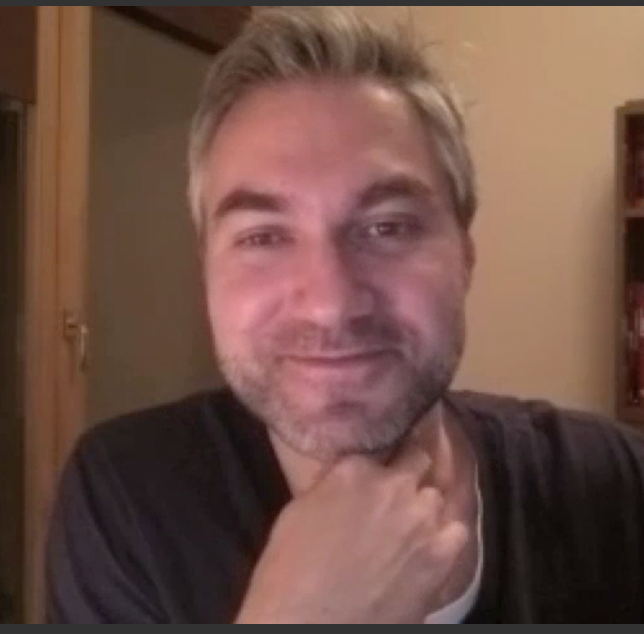[I didn't start out to do a post on 6 Bullets To Hell. It just happened. I don't have the video edited that should go with this - the Q&A after the film - and I'll add it later. This post just wrote itself.]

The face you see on the screen is not always a face you'll recognize off the screen. I tried to take a couple of pictures of the opening of
6 Bullets To Hell to be able to give you a sense of the kitchy spaghetti western look in the titles and images. I was too late, but this image from the screen turned out useful because I had - unknowingly - just taken Crispian Belfrage's picture with Ken Luckey. I'm still not sure who this is. I thought it was the hero Bill Rogers. But as I look at the actors, I'd say it looks more like Ken Luckey than Crispian Belfrage, who played Rogers. Luckey played Joseph 'Two Gun Joe' Ross, a scuzzy guy with yellow teeth.
6 Bullets To Hell is one of those films I'm not sure what to do with. Is it cool because it's an homage Sergio Leone? Or is the homage idea just a way to get away with a tacky movie? Was it an excuse for these guys to go to a grown up summer camp in Spain and make a movie? It mostly followed the spaghetti plot line (
from Wikipedia):
Sergio Leone's A Fistful of Dollars established the Spaghetti Western as a novel kind of Western. In this seminal film the hero enters a town that is ruled by two outlaw gangs and ordinary social relations are non-existent. He betrays and plays the gangs against one another in order to make money. Then he uses his cunning and exceptional weapons skill to assist a family threatened by both gangs. His treachery is exposed and he is severely beaten, but in the end he defeats the remaining gang. The interaction in this story between cunning and irony (the tricks, deceits, unexpected actions and sarcasms of the hero) on the one hand, and pathos (terror and brutality against defenseless people and against the hero after his double play has been revealed) on the other, was aspired to and sometimes attained by the imitations that soon flooded the cinemas.
In this case the hero has given up being a gunfighter for farming. (Thus the first question in the Q&A which I'll get up eventually.) It's the outlaw gang that comes into town. I don't recall any deceit by the hero. He went up to each target and told them he had come to kill him. We certainly had scenes of terror and brutality - particularly the gang rape and murder of the hero's pregnant wife. One can argue that this film portrays the rapists as disgusting thugs who all get killed in the end and so it tells a moral tale. But the good guys are all good and the bad guys are mostly all bad. One did halfheartedly protest the rape and murder, but he was quickly killed. He should have pulled out his gun and shot a couple of the gang since he ended up dead anyway. But then there would have been no need for the hero. Some of you may be detecting my attempt to be fair with a movie that has such gratuitous violence (we really don't see any actual sex). I'm thinking I should have asked them about how they felt about adding one more violent gang rape and murder to the endless such images that are already on the screen. Was it better than
The Lookalike because it was an homage? Or because there were clear distinctions between the good guys and bad guys? Or because it was outdoors mostly? Or was
The Lookalike better because the characters were more nuanced? In both most of the women were basically sex objects for men and some got shot.
Better to compare it with the opening night film
WildLike which looks at sexual abuse from the abused perspective, where we see the social and emotional impacts on the young girl. Or
I Believe In Unicorns which also has a younger girl seduced by an older (but not that much) guy. In these films there was little violence.
WildLike portrayed the lead up to sex, but then cutaway.
Unicorns was more overtly sexual, but the kids had some clothes on, and the nature of their sexual relationship was important to understanding the story.
They clearly were having fun being in Alaska, and the audience made me proud with their unexpected questions and (expected) hospitality. Here the crew are getting some pictures together in front of the film festival sign.
 |
| Russel Cunningham, Luckey, Tanner Beard, Belfrage, and friend (r-l) |
I probably would have skipped 6 Bullets to Hell since I knew it was not my type of movie. But it played at 10pm, there was no other films on at that time, and I was already at the Bear Tooth. The Q&A was more entertaining than the film and I'll add that here when I get the video ready.
Any movie can give one something to chew on. I'm not sorry I saw this one. I enjoyed talking to the actors who were there. They were genuinely decent guys. I just keep thinking though, that we have relatively little time on earth and we should be thinking how what we do makes the world a better place to be, helps make humans more hopeful and decent to each other. Maybe they'll take the experience they got from this film to make future films that add a little more understanding and insight into the world.









